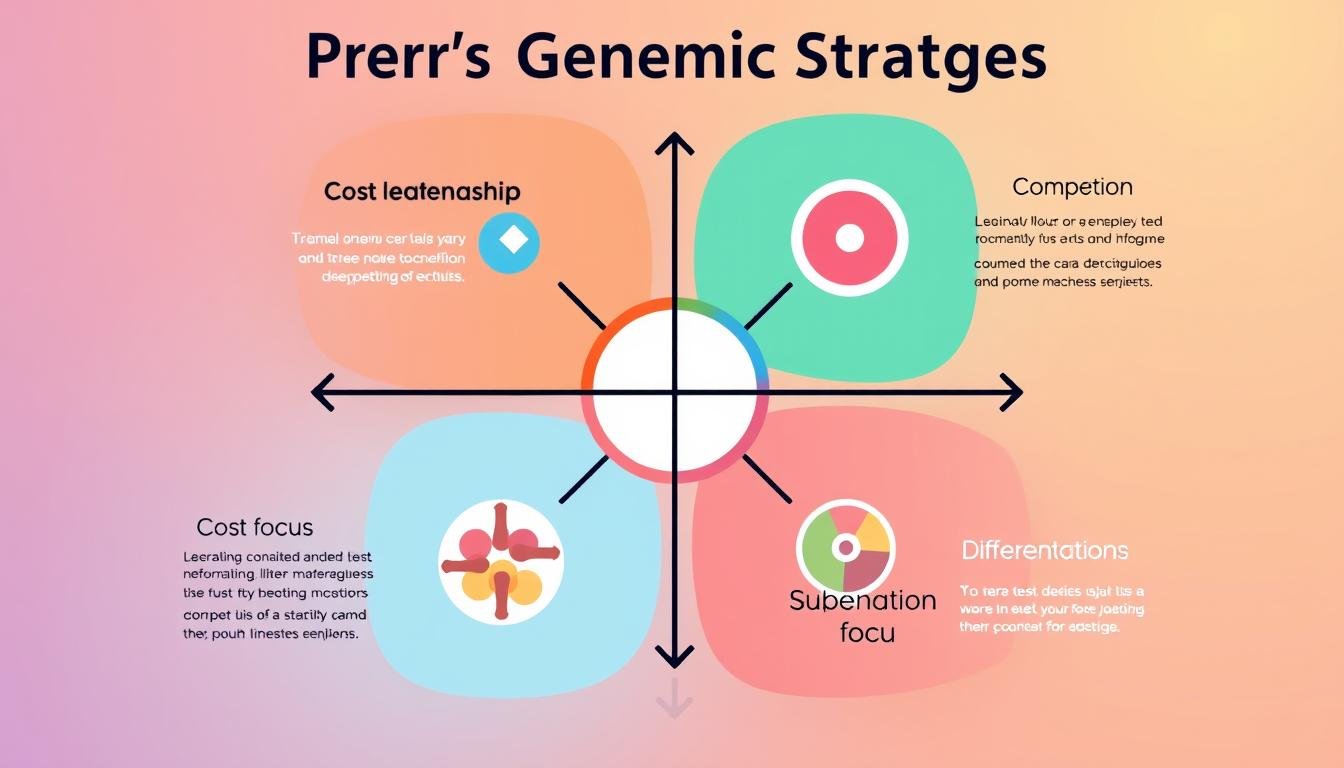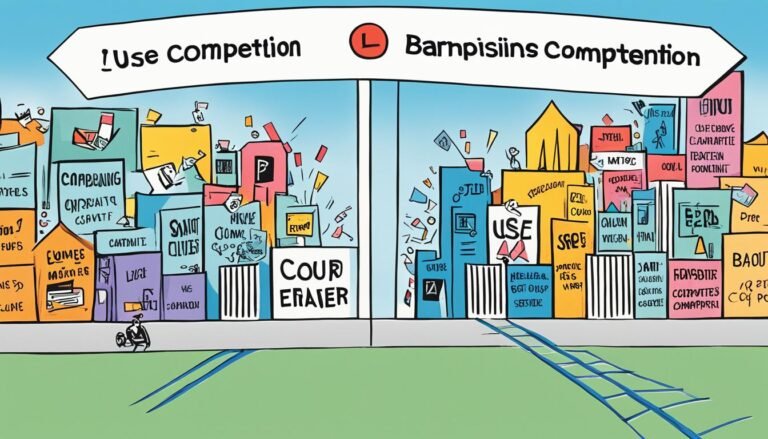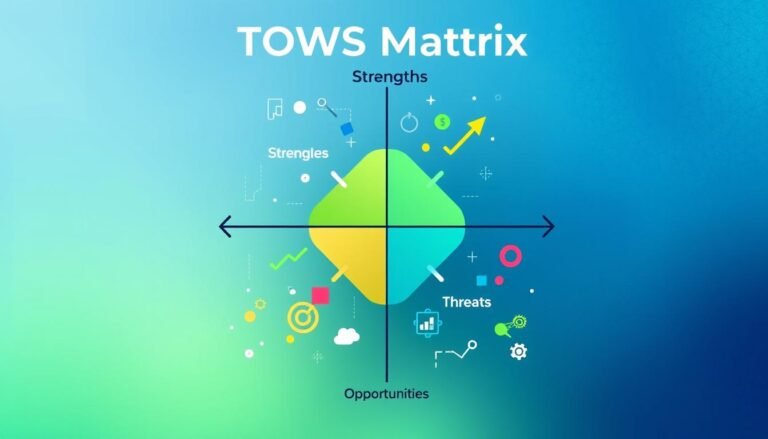Porter’s Generic Strategies: Business Success Models
Ever wondered why some companies do well while others struggle, even with similar products? It’s often their business strategies. Michael Porter’s Generic Strategies are key to winning in the market. They help decide how well a company will do.
In his famous work, “Competitive Advantage,” Porter shared three main strategies: cost leadership, differentiation, and focus. This piece will dive into these strategies. It will help businesses boost their profits and find success in a tough market.
Key Takeaways
- Porter’s Generic Strategies include cost leadership, differentiation, and focus.
- Cost leadership targets a broad market through low-cost production strategies.
- Differentiation offers unique value, allowing firms to charge premium prices.
- The focus strategy centers on niche markets for either cost advantage or differentiation.
- Companies can be ‘stuck in the middle’ if they attempt to combine strategies.
- High market share often correlates with increased profitability.
- Successful firms align their internal strengths with their chosen generic strategy.
Introduction to Competitive Advantage
Having a competitive edge is key for any business to beat its competitors. This edge can come from being cheaper, offering something unique, or standing out in the market. It’s important for companies to study their competition to find the best strategies for them.
In the 1980s, Michael Porter came up with the Generic Strategies model. This model helps us see how companies can get ahead. Companies should think about if they can be the low-cost leader like Walmart or stand out with unique products like Apple. The choice affects how well a company does in the long run and its success in the market.
Porter said that having a strong competitive advantage helps a company do better in its industry. For example, being the low-cost leader means making things cheaper. On the other hand, focusing on being different can mean making products that grab customers’ attention. Knowing this is key for any business wanting to get ahead.
Companies can also focus on a specific market, like Southwest Airlines does. In a tough market, being able to use a competitive advantage is crucial for staying profitable and doing well.
| Strategy | Key Focus | Example Companies |
|---|---|---|
| Cost Leadership | Lower production costs | Walmart, Aldi, IKEA, McDonald’s |
| Differentiation | Unique product offerings | Apple, Starbucks, Nokia |
| Focus Strategy | Niche markets | Southwest Airlines, PepsiCo |
Companies that focus on a strong competitive advantage can better handle their industry’s challenges. This puts them in a good spot in the market.
Understanding Porter’s Generic Strategies
Porter’s Generic Strategies give companies a clear path to stand out in the market. These strategies include Cost Leadership, Differentiation, and Focus. Each one offers a way for companies to lead in their field.
The Cost Leadership strategy aims to be the cheapest in an industry. This lets companies offer prices that others can’t beat. Brands like Southwest Airlines use this strategy by being very efficient and using resources wisely.
On the other hand, the Differentiation strategy is about making a product stand out. Companies that use this strategy invest in research and marketing to attract customers looking for something unique. This can lead to higher prices and loyal customers.
The Focus strategy targets a specific market to be the top choice there. Companies can focus on being the cheapest in a niche or offer unique products. But, this strategy can also attract competitors to the same market.
Knowing these strategies is key for companies wanting a lasting edge. Choosing one main strategy helps avoid being stuck in the middle. Sometimes, mixing strategies can work too, offering flexibility without losing focus.
| Strategy | Description | Focus Areas | Examples |
|---|---|---|---|
| Cost Leadership | Becoming the lowest-cost producer in an industry. | Operational efficiency, Cost control | Southwest Airlines, Walmart |
| Differentiation | Creating unique products that provide added value. | Innovation, Branding, Unique features | Apple, Tesla |
| Focus | Targeting a narrow market segment. | Market specialization, Tailored products | Rolls-Royce (Luxury cars), Whole Foods (Organic products) |
Cost Leadership Strategy
Cost leadership is a key strategy in business. It means being the lowest-cost producer in your industry. This approach helps attract customers who look for the best deals.
It focuses on making production efficient. This lets companies offer lower prices and still make a profit.
Definition and Importance of Cost Leadership
Cost leadership is about selling products or services at the lowest cost. Companies that are low-cost producers use big scale and efficient processes. This helps them reach more customers who want affordable options without losing quality.
Examples of Successful Cost Leaders
Walmart and Ryanair are great examples of cost leadership in action. Walmart saves costs with its large network and efficient logistics. Ryanair attracts travelers by offering low prices without extra services.
Challenges and Considerations in Cost Leadership
Cost leadership has big benefits but also big challenges. Keeping costs low without losing quality is hard. Companies must always work on being efficient and controlling costs to stay on top.
As competition grows, losing quality can hurt a company’s success over time.
Differentiation Strategy
A differentiation strategy helps companies make unique products and services. This makes them stand out in the market. By offering something special, companies can charge more and keep customers coming back.
This strategy is not just about being different. It’s also about always innovating and focusing on quality.
What is Differentiation?
Differentiation means making products that are clearly better than what others offer. Companies do this by adding special features, better performance, or unique designs. This makes their products more valuable.
Being unique lets companies charge more. This leads to more profit and loyal customers.
Key Characteristics of a Differentiation Strategy
- Innovation: Always improving and being creative with new products.
- Exceptional Service: Giving customer service that goes above and beyond.
- Unique Branding: Building a strong brand that draws in loyal customers.
- Quality Focus: Keeping high standards in making products.
Successful Companies Using Differentiation
Many famous brands use a successful differentiation strategy. Apple and Starbucks are great examples. They focus on quality, innovative designs, and strong customer connections.
These companies make products and experiences that really speak to their customers. This shows how a good differentiation strategy can build strong brand loyalty.
Focus Strategy
The focus strategy is all about zeroing in on specific parts of the market. This way, companies can better meet the needs of certain customers than their rivals. By focusing on niche markets, businesses can create products that really speak to their audience, building strong loyalty.
What is the Focus Strategy?
This strategy means picking a certain market segment and really understanding what they want. Companies can then use their resources to hit the mark with this group. There are two main types: cost focus and differentiation focus.
Variants of Focus Strategy: Cost Focus and Differentiation Focus
Cost focus is about being the cheapest in a niche. By keeping costs down and big, companies can offer great prices and still make money. Differentiation focus, on the other hand, is about offering something unique to the market. Companies make products or services that really stand out because of their special features or brand.
Successful Examples of Focus Strategy
Many brands show how well the focus strategy works in niche markets. Aldi, for example, targets customers who want to save money. Ducati and Ferrari, meanwhile, focus on giving high-performance cars to those who value quality. These examples prove that tailoring strategies to specific audiences is key to success.
Combining Strategies: Stuck in the Middle
Companies face big risks when they get stuck in the middle. They fail to pick a clear low-cost or differentiation strategy. This leads to strategic mediocrity, making it hard for them to compete in their markets. They struggle to keep customers and often face a competitive disadvantage.
The Risks of Being Stuck in the Middle
Being stuck in the middle can hurt a company’s market position. Firms might try to mix strategies, but without a clear plan, they could end up spending too much on features that don’t add value. This indecision can lead to losing market share and hurting their brand.
To show this, Circuit City tried to compete with both discount stores and specialized shops. But, they couldn’t keep up and went bankrupt.
Examples of Companies in the Middle Ground
Here are some examples of companies that failed because they were stuck in the middle:
- Circuit City closed in 2009 because it couldn’t beat retailers like Best Buy and Walmart.
- Blockbuster went bankrupt in 2011, unable to match Netflix’s better convenience and prices.
- IBM left the personal computer market after it couldn’t stand out in a crowded field dominated by Dell.
| Company | Issue | Outcome |
|---|---|---|
| Circuit City | Struggled to compete on price | Filed for bankruptcy in 2009 |
| Blockbuster | Failed to adapt to streaming services | Bankruptcy in 2011 |
| IBM | Inability to differentiate personal computers | Exited the PC market |
Knowing these risks is key for companies wanting to stay competitive. By having a clear strategy, they can dodge the dangers of being stuck in the middle.
Porter’s Generic Strategies: Practical Applications
Using Porter’s Generic Strategies means looking closely at what a company can do and what the market needs. It’s important to pick a strategy that fits with the company’s goals and what it can do. This choice is key to doing well over time and making sure the strategy works in today’s changing market.
How to Implement Porter’s Generic Strategies
To put these strategies into action, companies often use tools like SWOT analysis. This helps them see their strengths, weaknesses, chances, and threats. By doing this, they can pick a strategy like cost leadership, differentiation, or focus that meets their current goals and gives them an edge in the long run. For example, Walmart and Tesla show how clear goals based on what customers want can lead to success.
Strategic Management and Competitive Positioning
Strategic management is key to understanding the market and choosing the right path to stand out. Studies show that using Porter’s strategies can help companies beat their rivals. Differentiation strategies often do better than focusing on costs or targeting a specific group. Companies face challenges like being new or becoming outdated. But, being able to quickly change and keep bringing new products and services can help them stay ahead.
Source Links
- Porter’s Generic Strategies
- Porter’s generic strategies
- Porter’s Generic Strategies: An Overview of Competitive Advantage — Helping Companies Deliver More Value Through Better Process Management | Bob Stanke
- How to Apply Porter’s Generic Strategies to Your Business | Lucidity
- An introduction to Porter’s Generic Strategies
- Porter’s Five Forces and Three Generic Strategies – MBA Knowledge Base
- Porter’s Generic Strategies explained
- Porter’s Generic Strategies: Competitive Advantage | Hsint Sanda| 31 Aug 2018
- Porter’s Generic Competitive Strategies (ways of competing)
- An Overview of Porter’s Generic Competitive Strategies
- Linking Porter’s generic strategies to firm performance – Future Business Journal
- Porter’s Generic Strategies Tips for Business Competitive Strategy
- Porter’s Generic Strategies EXPLAINED with EXAMPLES | B2U
- Generic Strategies
- Stuck In The Middle Of Porter’s Generic Strategies
- Stuck in the Middle







